HOW TO SHOE A KNEESPRUNG OR KNUCKLER
 NEESPRUNG is the result of disease that sometimes is brought about by bad shoeing. In a healthy leg the center of gravity is down through the center of the leg and out at the heels. This is changed in a case of kneesprung legs, giving the legs a bowed appearance. This trouble always comes on gradually; in some cases it will stop and never get worse, while in others it will keep on until it renders the horse useless. A horse with straight legs will sleep standing, but a knuckler cannot; he will fall as soon as he goes to sleep, on account of the center of gravity being thrown on a line forward of the suspensory ligaments. The cause of this trouble is sprain or injury to the back tendons of the legs; soreness of the feet, shins or joints. In old cases nothing can be done but just to relieve the strain a little by shoeing with a long shoe and high heel calks, with no toe calk. In cases not more than three months old clip the hair off the back tendons when there is any soreness, and shower them with cold water
several times a day for a week or two, and then turn the horse out for a long run in the pasture.
NEESPRUNG is the result of disease that sometimes is brought about by bad shoeing. In a healthy leg the center of gravity is down through the center of the leg and out at the heels. This is changed in a case of kneesprung legs, giving the legs a bowed appearance. This trouble always comes on gradually; in some cases it will stop and never get worse, while in others it will keep on until it renders the horse useless. A horse with straight legs will sleep standing, but a knuckler cannot; he will fall as soon as he goes to sleep, on account of the center of gravity being thrown on a line forward of the suspensory ligaments. The cause of this trouble is sprain or injury to the back tendons of the legs; soreness of the feet, shins or joints. In old cases nothing can be done but just to relieve the strain a little by shoeing with a long shoe and high heel calks, with no toe calk. In cases not more than three months old clip the hair off the back tendons when there is any soreness, and shower them with cold water
several times a day for a week or two, and then turn the horse out for a long run in the pasture.
Contraction is in itself no original disease, except in a few cases. It is mostly the effect of some disease.
 |

When contraction comes from bad shoeing or from standing on hard floors, pull the shoes off, pare down the foot as much as you can, leaving the frog as large as it is. Rub in some hoof ointment once a day at the coronet and quarters, and turn the horse out in a wet pasture. But if the horse must be used on the road, proceed to shoe as follows: First, ascertain if the frog is hard or soft. If soft, put on a bar shoe with open bar. I have invented a shoe for this purpose. See Fig. 2, No. 1. The idea of shoeing with an endless bar shoe is wrong. In most cases contraction is brought on by letting the shoes stay on too long, whereby the hoof has been compelled to grow down with the shape of the shoe.
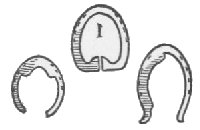
Make a low box and fill it with wet manure, mud or clay, and let the horse stand in it when convenient, to soften the hoofs. Spread the shoe a little every week to help the hoofs out, or the shoes will prevent what the frog pressure aims to do, but this spreading must be done with care. If the frog is dried up and hard, don't put on a bar shoe, as it will do more harm than good. In such a case make a common shoe with low or no calks; make holes in it as far back as you can nail; spread them with care a little every week. Let the horse stand in a box with mud or manure, even warm water, for a few hours at a time, and keep the hoofs moist with hoof ointment. In either case do not let the shoe stay on longer than four weeks at a time. In addition to the above pack the feet with some wet packing, or a sponge can be applied to the feet and held in position by some of the many inventions for this purpose.
No man can comprehend how much a horse suffers from contraction when his feet are hoof-bound and pressed together as if they were in a vise. The pain from a pair of hard and tight boots on a man are nothing compared to the agony endured by this noble and silent sufferer. It must be remembered that there is no such a thing as shoeing for contraction. Contraction is brought on by artificial living and shoeing. A bar shoe for contraction is the most foolish thing to imagine. The pressure intended on the frog is a dead pressure, and in a few days it will settle itself so that there is no pressure at all. If a bar shoe is to be used it must be an open bar shoe like the one referred to. This shoe will give a live pressure, and if made of steel will spring up against the frog at every step and it can be spread. I will say, however, that I don't recommend spreading, for it will part if not done with care. It is better to drive the shoe on with only four or five nails, and set them over often.
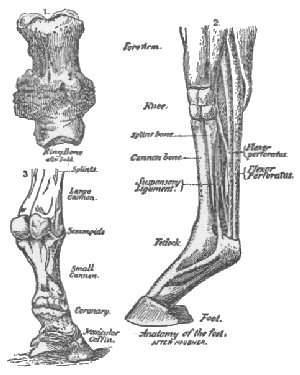
Corns are very common to horses' feet, a majority of all cases of lameness is due to this trouble.
Corns are the result of shoes being allowed to stay on too long. The shoe, in such a case grows under the foot and presses on the sole and corns are formed. Even pressure of the shoe and sometimes too heavy bearing on the heel causes corns. Gravel wedging in under the shoe or between the bar and the wall is sometimes the cause of corns. Leaving the heel and quarters too high, whereby they will bend under and press against the sole, is another cause of corns.
The seat of corns is generally in the sole of the foot at the quarter or heels between the bar and the wall, at the angle made by the wall and bar.
Anything that will bruise the underlying and sensitive membrane of the sole will produce corn. This bruise gives rise to soreness, the sole becomes blood colored and reddish: if bad it might break out, either at the bottom or the junction of the hoof and hair or coronet, forming a quittor.
Cut out the corn or red sole clear down. If the corn is the result of contraction pare down the hoof and sole, put the foot into linseed poultice that is warm, for twenty-four hours, then renew it. If the corn is deep, be sure to cut down enough to let the matter out. It is a good thing to pour into the hole hot pine tar. In shoeing the bearing should he taken off the quarter or from the wall over the corn by rasping it down so that it will not touch the shoe. A bar shoe is a good thing as it will not spring as much as to come in contact with the hoof over the corn. Give very little frog pressure. An open shoe can be used and in
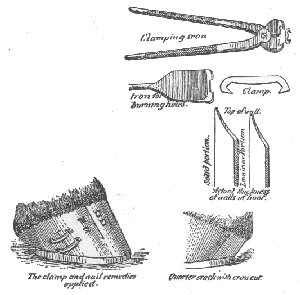
such a case there should be no calk at the heel. A calk should be welded on directly over the corn and the shoe will not spring up against the wall.
Quarter and sand cracks are cracks in the hoof, usually running lengthwise of the fibers, but sometimes they will be running across the fiber for an inch or more.
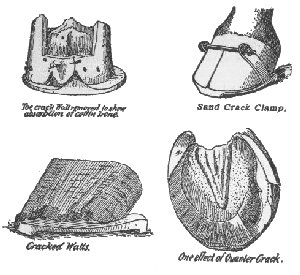
Quarter cracks are cracks mostly on the inside of the hoof, because that side is thinner and weaker than the outside. The cause of it is a hard and brittle hoof with no elasticity, brought on by poor assimilation and a want of good nutrition to the hoof. Hot, sandy or hard roads are also conducive to these cracks. What to do: If the horse is shod remove the shoes, and cut off the wall of the quarter to take off the bearing on both sides of the crack. If the crack goes up to the coronet and is deep, cut off both sides of the crack the whole length. About one inch below the coronet, cut a deep cut clear through either with a knife or hot sharp iron across the crack. This will help to start a new hoof.
If the flesh sticks up between the cracks, let a veterinarian burn it off. In shoeing for this trouble, it is best to use a bar shoe (endless) and shoe the horse often.
When shoes with a clip or a cap on the toe are used it sometimes happens that the toe is bruised and it starts a dry rot extending up between the wall and the laminæ. Remove the shoe, pare away the hoof at the toe so as to take away the bearing from the toe. Any white or meaty substance should be picked out. Apply hot pine tar into the hole, and clip a little wad of tow in the hole to fill up. Replace the shoe, but don't let the clip touch the wall.
Pricking often happens in shoeing from a nail running into the quick, but the horse is often pricked by stepping on a nail or anything that will penetrate the sole and run into the quick. If the horse is pricked by shoeing pull off the shoes and examine each nail, the nail which has gone into the quick is wet and of a blue color.
If it is a bad case the sole or wall must be cut down to let the matter out and the foot put into a boot of linseed poultice. In milder cases a little pine tar put into the hole will be enough.
Mistakes are often made by inexperienced men and horse-shoers when a case of this kind is to be treated, and I would advise every horse-shoer to call in a veterinarian when he gets a case of this kind. Cramps of the muscles of the thighs are sometimes taken for stifle.
When stifle appears in an old horse, three ounces of lead through his brain is the best, but for a young horse a cruel method of shoeing might be tried. Make a shoe with heels three inches high, or a shoe with cross bands as shown in illustration, Figure 8, No. 2, for stifle shoe. This shoe must be placed on the well foot. The idea is to have the horse stand on the stifled leg until the muscles and cords are relaxed.
String halt or spring halt is a kind of affection of the hind legs, occasioning a sudden jerk of the legs upward towards the belly. Sometimes only one leg is affected.
In some cases it is milder, in others more severe. In some cases it is difficult to start the horse. He will jerk up on one leg and then on the other, but when started will go along all right.
For this fault there is no cure because it is a nervous affection. If there is any local disorder it is best to treat this, as it might alleviate the jerk. For the jerk itself bathe the hind quarters once a day with cold water. If this don't help try warm water, once a day for two weeks. Rub the quarters dry after bathing.
Many devices are now gotten up for shoeing kicking horses. It is no use for a man to wrestle with a horse, and every horse-shoer should try to find out the best way to handle vicious horses.
One simple way, which will answer in most cases, is to put a twist on one of the horse's lips or on one ear. To make a twist, take a piece of broom handle two feet long, bore a half-inch hole in one end and put a piece of a clothes line through so as to make a loop six inches in diameter.
Another way: Make a leather strap with a ring in, put this strap around the foot of the horse; in the ring of the strap tie a rope. Now braid or tie a ring in the horse's tail and run the rope through this ring and back through the ring in the strap, then pull the foot up. See Fig. 16. The front foot can he held up by this device also, by simply buckling the strap to the foot and throwing the strap up over the neck of the horse.
Shoeing stalls are also used, but they are yet too expensive for small shops.
No horse-shoer should lose his temper in handling a nervous horse and abuse the animal; for, in nine cases out of ten, will hard treatment make the horse worse, and many horse owners would rather be hit themselves than to have anybody hit their horse.
 |
Don't curse. Be cool, use a little patience, and you will, in most cases, succeed. To a nervous horse you should talk gently, as you would to a scared child. The horse is the noblest and most useful animal to man, but is often maltreated and abused. Amongst our dumb friends, the horse is the best, but few recognize this fact.
In shoeing a trotter it is no use to follow a certain rule for the angle, because the angle must vary a little in proportion to the different shape of the horse's foot.
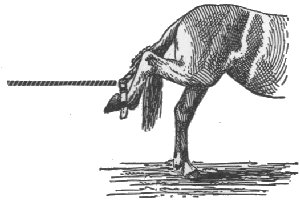
Every owner of a trotter will test the speed by having shoes in different shapes and sizes, as well as having the feet trimmed at different angles, and when the angle is found that will give the best results the owner will keep a record of the same and give the horseshoer directions and points in each case.
The average weight of a horse-shoe should be eight ounces. Remember this is for a trotter. Make the shoe fit to the edges of the wall so that there will be no rasping done on the outside. In farm and draft horses this is impossible, as there is hardly a foot of such a uniform shape but what some has to be rasped off.
Use No. 4 nails, or No. 5.
Don't rasp under the clinches of the nails.
Make the shoes the shape of No. 1, Figure 8.
Sometimes it is difficult to shoe so as to make the shoe stay on on account of poor and brittle hoofs. In such a case the shoe should be fitted snug. Make a shoe with a toe clip.
In weak heels the hoof is found to be low and thin from the quarters back. The balls are soft and tender. The shoes should not touch the hoof from the quarters back to the heels. An endless bar shoe is often the best thing for this trouble, giving some frog pressure to help relieve the pressure against the heels.
Founder is a disease manifested by fever in the feet in different degrees from a simple congestion to a severe inflammation. It is mostly exhibited in the fore feet, being uncommon in the hind feet. The reason for this is the harder pressure, a much greater amount of weight coming on the front feet, the strain and pressure on the soft tissues heavier. The disease is either acute or chronic, in one foot or both. When both feet are diseased the horse will put both feet forward and rest upon the heels so as to relieve the pressure of the foot. If only one foot is affected that foot is put forward and sometimes kept in continual motion, indicating severe pain. The foot is hot, especially around the coronary band. The disease, if not checked, will render the horse useless. When such a horse is brought to you for shoeing it would be best to send him to a veterinarian.
How to shoe: Let the horse stand in a warm mud puddle for six hours, then put on rubber pads or common shoes with feet between the web of the shoe and the hoof, with sharp calks to take up the jar. It would be best not to shoe at all, but let the horse loose in a wet pasture for a good while.
Chapter 11
Chapter 9
Return to Main Page
© 2000, 2001 by Lynn Waterman